Study Examines Long-Term Health Effects of Soy Infant Formula |
|
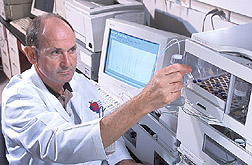 Neuroendocrinologist Thomas Badger inserts a sample into a mass- spectroscopy unit to measure soy isoflavones in mammary gland epithelial cells. Studies at ACNC have shown that animals fed diets high in soy have a lower incidence of breast cancer. Epithelial cells are studied because they are the cells that develop into breast cancer. (K10898-1) |
A mother and father have so many decisions to make for their newborn baby—decisions that can profoundly influence their boy's or girl's development. The first decision they make might concern how to feed their baby. After gathering facts on all the available options, different parents reach different conclusions about what's best for their child. ARS nutrition researchers in Little Rock, Arkansas, hope to uncover more information to help parents make this important decision. They're investigating the long-term effects of soy infant formula—an increasingly popular feeding choice. A 2000 Surgeon General's report found that 64 percent of American women breast-feed during their infants' first weeks of life. But after 6 months, that figure drops to 29 percent for many reasons. Once a parent has chosen formula feeding, most pediatricians will recommend cow's milk-based formula over soy-based formula for most babies. But doctors will recommend soy formula if they believe an infant should avoid cow's milk protein and/or lactose (milk sugar) or if the baby simply doesn't tolerate milk-based formula. There are lactose-free milk-based formulas available now, but some parents, including vegetarians, still prefer soy-based formulas. |
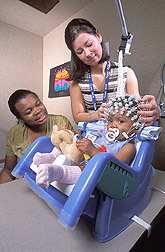 Research assistant Lisa Witcher places a neural net on an 8-month-old study participant while explaining the data collection process to the child's mother. The neural net records brain wave activity. (K10901-1) |
Although soy infant formulas are now consumed by 20-25 percent of formula-fed infants in America, there is little research on the immediate and long-term health and cognitive effects of this diet in humans.
A 1998 report from the American Academy of Pediatrics maintains that "isolated soy protein-based formulas are safe and effective alternatives to provide appropriate nutrition for normal growth and development" in term infants not being fed breast milk or cow's milk-based formulas. But some child-advocacy groups claim that consuming soy-based formula could accelerate puberty and cause developmental and reproductive abnormalities and thyroid disorders later in life. Previous studies at ARS's Arkansas Children's Nutrition Center (ACNC) in Little Rock and elsewhere found no apparent long-term positive or negative effects of feeding infants soy versus cow's milk formula. But there are no long-term, systematic studies of the effects of soy formula on development, growth, and central nervous system function. To help clarify the issue, Thomas M. Badger, ACNC director and a professor in the College of Medicine at the University of Arkansas for Medical Sciences (UAMS) in Little Rock, is leading a 6-year study—begun in September 2002—to compare the effects of soy infant formula with those of breast milk and cow's milk formula. |
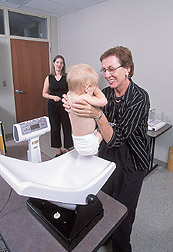 Nutritionist Pat Wiggins weighs a 1-year-old boy while his mother watches. (K10899-1) |
Isolating Soy Protein for Study Soy-based infant formulas contain soy protein isolate (SPI). Isoflavones are bound to soy proteins in high amounts. They're a class of phytoestrogens, which are plant derived and presumably healthful. One controversial aspect of soy-based formula involves isoflavones because they're believed to act similarly to the female hormone estrogen. Critics suggest that isoflavones in soy formula might disrupt or impair development in infants. But taking into account previous ACNC findings, Badger suspects that soy isoflavones are not acting like female hormones in infants. In studies of several generations of rats fed high levels of soy protein, Badger and his team found they grew and developed normally, except for very minor differences that have not been found in humans. There were no harmful effects, but there were many beneficial health effects. |
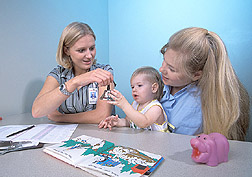 Psychological examiner Mindy Lester (left) uses the Bayley Scales of Infant Development Assessment to conduct a developmental assessment on a 1-year-old girl. The child's mother is pleased to see her daughter's progress since the previous study visit. (K10903-1) |
Still, ACNC researchers have found some reason to be concerned about possible drawbacks of soy proteins: They could affect a body system involved in drug metabolism.
The scientists found that SPI-containing diets fed to young rats increase activities of phase I and II detoxification systems, which are involved with metabolizing toxins in the body. These beneficial systems can actually remove substances that cause diseases such as cancer. But studies also showed that soy consumption altered certain phase I enzymes found in the liver, gut, and other organs. These enzymes—in the CYP3A family—are responsible for metabolism of about 80 percent of all clinical medications taken by humans and other animals. Martin J.J. Ronis, a toxicologist at ACNC and a professor at UAMS, is conducting studies to see whether increased CYP3A could reduce drug levels faster than normal and consequently reduce their beneficial effects. High levels of these enzymes were found in rats fed large amounts of soy, and even higher amounts were found after they were given medications. |
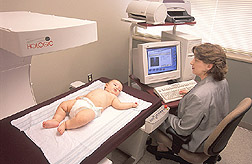 Dual energy X-ray absorptiometry (DXA) is used to measure bone density and body composition. Nutritionist Janet Gilchrist analyzes a DXA scan completed on a 6-month-old boy. (K10900-1) |
"We found that SPI-fed rats had an increased phase I metabolism," Badger says. "This has two implications. First, these enzymes are responsible for activation and deactivation of toxic materials, including procarcinogens and carcinogens. This may be one mechanism by which SPI reduces the incidence and number of mammary and colon cancers."Second, since medications are also metabolized by these enzymes, it's possible that drug efficacy is affected. We're currently studying this effect in infants who are fed soy formula and comparing it to breast-fed and milk formula-fed babies." Bringing in Baby Pat Wiggins and Jill Brackenbury, nutritionists at ACNC, are co-leading the clinical portion of the ARS-supported infant study, which is building on previous research at the center on the effects of soy in animals. |
|
|
"Soy-based formula has been commercially available since the sixties," Wiggins says, "but few studies have examined the long-term consequences of exposure to high concentrations of estrogenic compounds during infancy. No one consumes more soy per kilogram of body weight than infants who are fed soy-based formula. Infants should consume about 115 calories per kilogram to maintain normal growth."
Three hundred eighty full-term, healthy infants will participate in the study at Arkansas Children's Hospital in Little Rock. Ninety-five babies will be recruited in each of four groups. One group will be exclusively breast-fed by their mothers; another group will be given milk-based formula supplemented with docosahexaenoic acid (DHA), a fatty acid recently made available in U.S. infant formulas; a third group will be given soy-based formula with DHA; and a fourth group, soy formula without DHA. DHA and another fatty acid, arachidonic acid, are found in small concentrations in breast milk. They were not available in U.S. infant formulas until 2002. It's believed that DHA improves infant visual function and that both compounds improve cognitive development, but more evidence is needed to prove this. ACNC conducted an extensive recruiting campaign throughout Little Rock and the surrounding community. Some babies were enrolled as newborns. Babies were selected on the basis of what their parents had already decided to feed them. There were no efforts to persuade parents to feed their babies a certain way. The researchers start monitoring infants when they're about 1 month old, checking for certain developmental milestones and collecting information on diet, growth variables, medical history, and brain function. Babies receive four brief health checks at 1, 2, 4, and 5 months of age. They receive extensive checkups at 3, 6, and 9 months and 1 year, then yearly until they are 6 years old. These longer evaluations include a dual energy X-ray absorptiometry (DXA) scan to measure the children's bone density and body composition. Badger says they expect to find that early exposure to soy supports normal bone mineralization and improves body composition. Also during the longer checkups, Terry Pivik and Roscoe Dykman, ACNC psychologists and UAMS professors, study the effects of the diets on brain function and on measures known to be predictive of later physical and mental development, including school achievement. They do this by recording brain wave activity from 128 different sites on each child's head as the child performs various tasks. The dense array of recording sites makes it possible to localize behavior to specific brain areas. The researchers also gather information on sleep patterns, aspects of the home environment and parental genetic influences, measures of IQ, and motor and mental development, because these variables are also predictive of later mental development and academic performance. As they wean to regular food, the children undergo periodic examinations to measure brain development and function. Says Badger, "We hope to determine how various dietary factors affect cognitive function, learning ability, and attention span." Perks of participating in the study include tests more thorough than the ones most babies would ordinarily receive. Parents receive free formula—or diapers if nursing. After 1 year, they receive $100 compensation for each yearly examination. Most importantly, they receive detailed periodic reports on the health of their babies. Kim Jones of Conway, Arkansas, enrolled her daughter, Kaleigh, who is being breast-fed, in the study in September 2002 when she was just 3 months old. Jones believes taking part in the study will benefit Kaleigh a great deal. "It's nice to have steady feedback on her growth," Jones says. "We'll see how she is progressing and reaching her developmental milestones."—By Jim Core, Agricultural Research Service Information Staff. This research is part of Human Nutrition, an ARS National Program (#107) described on the World Wide Web at www.nps.ars.usda.gov. Thomas M. Badger is with the USDA-ARS Arkansas Children's Nutrition Center, 1212 Marshall St., Little Rock, AR 72202; phone (501) 364-2785, fax (501) 364-2818. "Study Examines Long-Term Health Effects of Soy Infant Formula" was published in the January 2004 issue of Agricultural Research magazine. |







